Mar 21, 2013 | News
The University of Birmingham is now offering a hands-on iRAP course for road safety engineers, managers, and other road sector professionals.
The first course, delivered in collaboration with iRAP, includes practical exercises, discussions and exposure to the iRAP software. The course will be delivered over five days (2-6 September 2013) in state-of-the-art teaching and learning facilities.
By the end of the course, the participants are expected to have acquired an understanding of the following:
- The fundamentals of the iRAP approach to risk assessment and mitigation.
- The concepts of risk mapping and performance tracking.
- The concept of star rating based on inspection data and road designs.
- The principles of developing a safer roads investment plan.
- The iRAP software.
To enrol in the course, visit: http://www.birmingham.ac.uk/students/courses/cpd/civil-engineering/irap.aspx#CourseOverviewTab.
Mar 19, 2013 | News
iRAP was recognised for its contributions to road safety at the annual FIA Region IV American Awards.
iRAP Regional Director, Julio Urzua, was recognised by FIA for his work on the creation and implementation of road safety initiatives for 2012, reaffirming motoring clubs commitments in strengthening the synergy between mobility and motorsport.
By the end of 2012, iRAP assessments had been undertaken in Argentina, Belize, Brazil, Chile, Colombia, Costa Rica, El Salvador, Guatemala, Honduras, Mexico, Nicaragua, Panama and Paraguay.

Mar 19, 2013 | News
As part of efforts to curb tremendously high numbers of road deaths and serious injuries, the Asian Development Bank (ADB), Bangladesh Roads and Highways Department (RHD) and iRAP have assessed roads that form the backbone of nation’s transport system.
The assessments occurred as part of the ADB’s first ‘road safety pipeline project’, which will ensure that the most urgent and cost-effective road safety programs are adopted as an integral part of the road safety policy of the Government.
During the project, it was estimated that deaths and serious injuries on the 1,300km of roads assessed cost more than US$300 million each year.
The majority of roads assessed are rated in the highest risk bands: 1- or 2-stars. The reasons for this are clear and include the fact that 80% of the roads where pedestrians are likely to use the road have no formal footpaths.
However, Safer Roads Investment Plans prepared in the project make the solutions equally clear. Construction of some 75km of footpaths on N4, for instance, could prevent more than 3,000 deaths and serious injuries over 20 years and save US$40 million in crash costs.
The project technical report is available for download.

Mar 19, 2013 | News
The two-year SENSOR project brings together 14 countries and builds on outstanding cooperation between automobile clubs, universities and road authorities.
Most countries in South East Europe are constructing new roads or rehabilitating existing roads to achieve mobility benefits. SENSOR enables these countries to use iRAP techniques to target investment so that they can raise the overall level of safety performance of routes in a measurable way.
SENSOR is co-financed by the South East Europe (SEE) Transnational Cooperation Programme and the European Union.
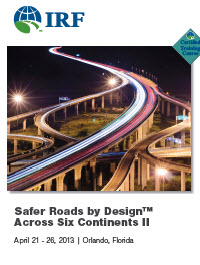
Mar 8, 2013 | News
For any road authority that has completed an iRAP assessment, the IRF’s “Road Safety Across Six Continents Seminar” can help put life-saving plans into practice.
The IRF’s Safer Roads by Design training program is among the most comprehensive in the world, and helps road authorities understand what can be done to meet their commitment to reduce deaths during the Decade of Action for Road Safety.
The training program focuses on four main topics: Roadside Safety, Work Zone Safety, Vulnerable User Safety, and Road Safety Audits.
For more information on the next program, to be held on April 21-26, 2013 in Orlando, USA, visit: http://www.irfnews.org/home/ or email: Mike Dreznes (mdreznes@irfnews.org).
Feb 27, 2013 | Report, Resources
Download Click the file icon above to download the file. 2013 iRAP Technical report – ADB Road Safety Program: Bangladesh

Feb 20, 2013 | News
Each day, more than six children die on their way to school in Mexico. iRAP is partnering with Safe Kids Mexico to help create safe environments for children to walk to and from school.
A pilot project is now being undertaken at a school in Mexico City, where a series of serious crashes in neighbouring streets have prompted calls for action.
Working with the University of North Carolina, iRAP is developing a tool that will eventually enable communities around the world to Star Rate roads around their schools and generate safety countermeasure plans.
The project is being supported by the Road Safety Fund.
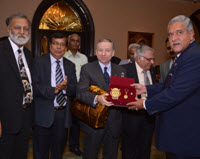
Feb 15, 2013 | News
FIA President Jean Todt and FIAA President Nitin Dossa recently saw first-hand efforts being made to improve safety in one of the world’s most populous countries.
Through the Action for Road Safety Campaign and its member clubs, FIA is working to help to reduce the road deaths in India, estimated to exceed 200,000 each year.
Government officials in Mumbai had the opportunity to view the survey vehicle used in iRAP assessments across seven States, review detailed road death investigation results and consider safety assessments for high-priority roads such as the Mumbai-Goa Highway which was the scene of a horrific crash that recently claimed 37 lives.
Feb 1, 2013 | Report, Resources
Download Click the file icon above to download the file. 2013 Conference paper – Best practices in road safety funding
Dec 1, 2012 | Report
Download Click the file icon above to download the file. 2012 iRAP report – Star rating road designs: Performance indicators for roads in India

Nov 30, 2012 | News
Leading news agencies in Mexico, including Reforma and terratv, have put a spotlight on the enormous cost of road crash deaths and serious injuries in the country, estimated to exceed US$50 billion each year.
The reports coincide with National Secretariat of Transport (SCT)-led iRAP assessments of more than 45,000km of roads. The assessments cover the federal highway network, including both toll-free and toll roads.
In addition to producing road safety Star Ratings for vehicle occupants, motorcyclists, pedestrians and bicyclists, it is anticipated that the assessments will identify countermeasures that could cut numbers of deaths and serious injuries by more than 25%.

Nov 30, 2012 | News
New road safety inspections are being undertaken by ChinaRAP, a partnership between the Research Institute of Highway (RIOH), Ministry of Transport, and iRAP.
The assessments involve inspections of urban roads in Mengzi and Jianshui (Yunnan) and highways in Shaanxi, and build on similar work already undertaken in Anhui.
The ChinaRAP road safety assessments will help guide multi-million dollar upgrades to the roads, which are financed by local governments and the World Bank and Asian Development Bank respectively.
In parallel to the assessments, ChinaRAP has also begun collaborating with other partners in the Bloomberg Philanthropies-funded Road Safety in 10 Countries Project (RS10). The collaboration is exploring ways that infrastructure improvements can complement efforts to reduce drink-driving rates and speeding in the cities of Dalian and Suzhuo.

Nov 30, 2012 | News
A report released by the International Transport Forum (ITF) at the OECD proposes 12 sets of measures to create safer walking environments.
The report laments that the number of pedestrians killed on roads is estimated at above 400 000 each year – about a third of annual road fatalities around the globe.
Earlier this, iRAP reported that 84% of the approximately 50,000km of roads assessed in low- and middle-income countries where pedestrians are present carry traffic at 40km/h or more and have no footpaths.
The ITF report is timely as pedestrian safety will be the focus of the United Nations Road Safety Week from 6-13 May 2013.
In addition to the new report, ITF is calling for nominations for the Young Researcher of the Year Award. This year’s winner, Ms Wing Yee (Winnie) Lam, a Chinese national, was honoured for a developing a walkability audit as an assessment tool to evaluate the walking environment in urban areas.
Nov 28, 2012 | Report, Resources
Download Click the file icon above to download the file. 2012 iRAP India Phase 2 summary report – Kerala State Transport Project
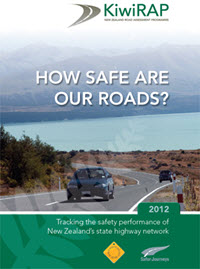
Nov 23, 2012 | News
The new KiwiRAP highway risk-ratings show safety has improved significantly on several Auckland and Northland State Highways over the past five years.
The length of road rated as high or medium-high risk reduced by 18% (from 475km to 388km) as a result of road improvements, including signage upgrades, an extension of roadside barriers, improved lighting and sealed shoulder widening, and targeted Police campaigns against speeding and drinking drivers.
NZTA’s Auckland and Northland Regional Director, Stephen Town said KiwiRAP is a powerful tool for increasing public awareness that not all highways are the same. “Drivers and riders who are aware of the higher risk highways can then adjust their driving to take extra care. Similarly, we can identify safety shortcomings that can then be addressed with practical road safety measures.
The new KiwiRAP report is available at: http://kiwirap.org.nz/downloads.html.
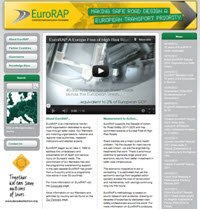
Nov 19, 2012 | News
EuroRAP began as an idea in 1999 to address the unnecessary and preventable toll of death and serious injury on Europe’s roads.
The commitment of its Members has won the programme overwhelming support. In the past decade EuroRAP has grown from a 4-country pilot to a programme now active in over 30 countries.
EuroRAP believes that in the next decade Europe can save at least 0.5% of GDP with an affordable, high return programme – saving at least 300 deaths and serious injuries every day.
To visit the new website, go to http://eurorap.org.
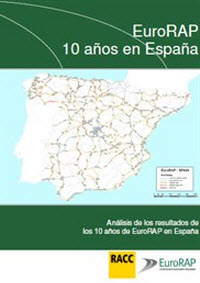
Oct 30, 2012 | News
To celebrate 10 years of EuroRAP in Spain, RACC have released EuroRAP 10 anos en Espana: Analisis de los resultados de los 10 anos de EuroRAP en Espana, looking back over the programme’s development and results.
The study details the evolution of different variables (such as length of the network, AADT and the number of fatal and serious crashes) used to generate EuroRAP risk ratings over the last 10 years, starting with the first EuroRAP study in 2002 through to the most recent in 2011.
The network analysed in the report covers the Spanish Road Network (RCE) spanning 23,528km. Although the total distance travelled on the RCE increased by 6% in the last 10 years, the number of deaths and serious injuries decreased by 58%.
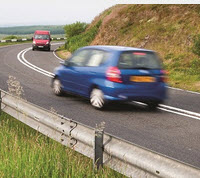
Oct 16, 2012 | News
Simple attention to safety engineering detail has resulted in extraordinary cuts in road deaths and serious injuries, according to the latest tracking survey by the Road Safety Foundation.
Engineering a Safer Future found that fatal and serious injury crashes on 10 stretches of treated road fell by nearly two thirds from 541 to 209 (2001-2005 and 2006-2010) – boosting the economy by £35m every year.
This year’s most improved road is a rural 20km (13 mile) single carriageway section of the A605. Over the two survey periods, fatal and serious crashes fell by 74% from 34 to 9, and its risk rating improved from medium in 2001-2005 to low-medium in 2006-2010.
Engineering a Safer Future was produced with support from Ageas UK. The report measures safety levels across 27,000 miles of motorway and A roads where the majority of UK road deaths occur.

Oct 11, 2012 | Espanol news
El club de automovilismo de Alemania, ADAC, ha encontrado que en redes extra-urbanas, cerca de 50% de las víctimas del tránsito pierden la vida en autopistas y carreteras federales, lo cual representa sólo 10% de la extensión de la red.
Los hallazgos se incluyen en el informe, Road Test 2008-2010 (Prueba en Carretera 2008-2010), que revisa las estadísticas de colisiones, presenta las Clasificaciones por Estrellas de EuroRAP y establece las acciones necesarias para salvar vidas.
El informe también indica que debido a la presencia de peligros laterales a la vía (árboles), las altas tasas de adelantamiento y las altas velocidades en las carreteras federales alemanas, se otorgan Clasificaciones por Estrellas más bajas que las autopistas alemanas y las vías extra-urbanas que soportan volúmenes similares de tránsito en otras partes de Europa.
El informe de la Prueba en Carretera complementa otras evaluaciones de seguridad de la infraestructura realizadas por ADAC; tales como Pedestrian Crossings in Europe (Cruces Peatonales en Europa), que evaluó la seguridad en 285 cruces en 19 ciudades.
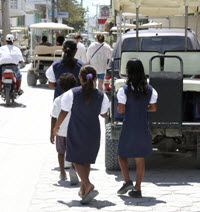
Oct 11, 2012 | Espanol news
El tramo de 80 km de la Autopista Occidental de Belice se tornará mucho más seguro gracias a los esfuerzos del gobierno y del Banco de Desarrollo del Caribe.
Una evaluación reciente de iRAP encontró que casi toda la autopista está clasificada con 1 ó 2 estrellas para ocupantes de vehículos, quienes representan el mayor número de muertes en las carreteras de Belice.
Como parte del proyecto, las mejoras en la infraestructura vial se complementarán con esfuerzos por crear conciencia entre los usuarios de las vías, lograr un mayor cumplimiento de las reglas de tránsito, tener una mejor respuesta post-colisión, y brindar mayor capacitación.
Después de que se completen las mejoras en la infraestructura, se utilizarán evaluaciones de IRAP adicionales para medir las reducciones en el nivel de riesgo.
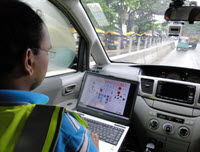
Oct 11, 2012 | Espanol news
Se tiene planeado realizar mejoras importantes en la seguridad de las vías de alto riesgo en Bangladesh.
La segunda ronda de evaluaciones de iRAP está enfocándose en cerca de 1,300 km de vías nacionales y regionales, muchas de las cuales serán modernizadas en los próximos años.
Las evaluaciones están siendo lideradas por el RHD y son parte del Road Safety Improvement Program (Programa de Mejoramiento de la Seguridad Vial) de ADB. El Programa es una de las iniciativas de seguridad vial más importantes del Banco en los últimos años e incluye inversiones tanto en fortalecimiento de capacidades como ejecución de proyectos.
iRAP está trabajando con consultores y grupos de interés locales, incluyendo BUET, BRAC y CIPRB. El proyecto también se ha beneficiado de la contribución voluntaria de Gina Waibl, una de las principales contribuyentes de KiwiRAP.
Oct 11, 2012 | Espanol news
Cerca de 45,000 km de vías han sido inspeccionadas como parte de la estrategia del Gobierno de México de brindar vías seguras para promover el desarrollo económico y social.
El proyecto de iRAP está siendo liderado por la Secretaría de Comunicaciones y Transporte (SCT) y utilizará las Clasificaciones por Estrellas para medir el riesgo de la infraestructura en 10% de las carreteras de la nación (un tercio de todas las vías pavimentadas).
Junto con los datos de iRAP, las inspecciones están recolectando datos sobre pavimentación que se utilizarán para la gestión de activos, haciendo muy costo efectivo el proceso. El proyecto también será el primero en utilizar el nuevo software en línea de iRAP, ViDA, que ofrece velocidades de procesamiento significativamente mayores y capacidad de elaboración de reportes más exhaustivos.

Oct 11, 2012 | Espanol news
Con el apoyo del Fondo Global para la Seguridad Vial y Bloomberg Philanthropies, Brasil y Egipto pronto iniciarán la Clasificación por Estrellas de redes viales estratégicas y prepararán Planes de Inversión para Vías Más Seguras.
La Organización Mundial de la Salud (OMS) estima que cerca de 60,000 personas mueren cada año en colisiones viales en Brasil y Egipto.
Las evaluaciones, que ahora se encuentran en las etapas de planificación preliminar, ayudarán a identificar las ubicaciones de los tramos de alto riesgo de la vía y propondrán tratamientos de ingeniería que sean asequibles, particularmente para los peatones quienes figuran notablemente en las estadísticas de mortalidad en las vías.
Los esfuerzos en Brasil y Egipto complementan las evaluaciones viales que ya se están realizando en Rusia, India y China también con el apoyo de GRSF y Bloomberg Philanthropies.

Oct 11, 2012 | Espanol news
El primer Taller de Innovación de iRAP se llevó a cabo en la oficina central de TRL en el Reino Unido y reunió a expertos en ingeniería de la seguridad vial de todo el mundo.
Los participantes del taller discutieron el hecho de que durante los próximos 12 meses se llevarán a cabo evaluaciones de iRAP en cerca de 150,000 km de vías en países de bajos y medianos ingresos – tres veces más que en los últimos cinco años.
Los participantes también consideraron formas en que la innovación en metodología, tecnología, políticas y procesos permitirá apoyar el crecimiento masivo de las evaluaciones y garantizar que los resultados se traduzcan en mejoras que permitan salvar vidas en las carreteras.
Las notas del taller que resumen las presentaciones hechas por los participantes están disponibles en línea para ser descargadas.
Oct 1, 2012 | Report, Resources
Download Click the file icon above to download the file. 2012 iRAP report – Vaccines for Roads: Second edition (English)

































